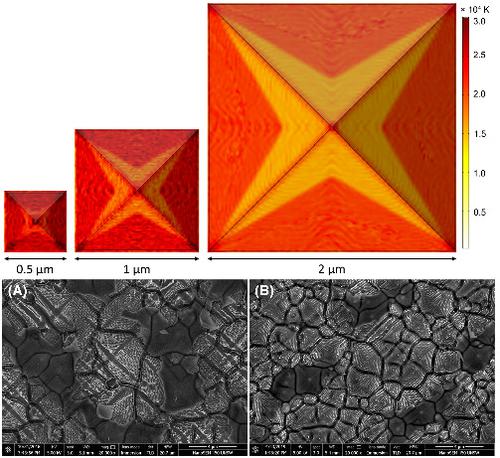当前位置:
X-MOL 学术
›
Prog. Photovoltaics
›
论文详情
Our official English website, www.x-mol.net, welcomes your
feedback! (Note: you will need to create a separate account there.)
Modelling picosecond and nanosecond laser ablation for prediction of induced damage on textured SiNx/Si surfaces of Si solar cells
Progress in Photovoltaics ( IF 8.0 ) Pub Date : 2021-05-11 , DOI: 10.1002/pip.3425 Xiaowei Shen 1 , Pei‐Chieh Hsiao 1 , Zhimeng Wang 1 , Mengdi Liu 1 , Benjamin Phua 1 , Ning Song 1 , Alex Stokes 2 , Alison Lennon 1
Progress in Photovoltaics ( IF 8.0 ) Pub Date : 2021-05-11 , DOI: 10.1002/pip.3425 Xiaowei Shen 1 , Pei‐Chieh Hsiao 1 , Zhimeng Wang 1 , Mengdi Liu 1 , Benjamin Phua 1 , Ning Song 1 , Alex Stokes 2 , Alison Lennon 1
Affiliation

|
This study investigated the laser-induced damage arising from 266 and 532 nm laser ablation of SiNx films on alkaline textured Si surfaces with nanosecond and picosecond pulse durations using a combination of optical-thermal simulations and measurements of carrier recombination current density. Simulations predict that the melting depth is limited to within 150 nm of the SiNx/Si surface after 266 nm ps laser irradiation due to the greater absorption in both the SiNx and Si resulting in more direct ablation, while temperatures exceeding the melting temperature of Si are predicted to extend up to 1000 nm into the Si substrate with 532 nm ps pulses leading primarily to spallation. Ablation of the SiNx by 266 nm ps irradiation is predicted to be more homogeneous on smaller sized pyramids due to the increased absorption of double-bounce reflected light on the pyramid faces. This finding has implications for applications requiring uniform ablation of dielectrics on textured Si surfaces. Ablation of SiNx by the longer wavelength 532 nm ps pulses also increases carrier recombination compared to that incurred with 266 nm ps pulses due to the increased melting depth. Longer ns pulses result in less steep temperature gradients and, for 266 nm pulses, an increased melting depth compared to ps pulses. Consequently, shorter ps UV pulses are preferred for SiNx ablation on Si surfaces due to their reduced laser damage penetration, whereas the less steep temperature gradients resulting from ns 532 nm pulses are beneficial for laser doping to form selective emitters.
中文翻译:

模拟皮秒和纳秒激光烧蚀以预测 Si 太阳能电池纹理 SiNx/Si 表面上的诱导损伤
本研究结合光热模拟和载流子复合电流密度的测量,研究了由 266 和 532 nm 激光烧蚀碱性纹理 Si 表面上的 SiN x膜引起的损伤,脉冲持续时间为纳秒和皮秒。模拟预测,熔化深度限制为在SiN为150nm内X由于在两个较大吸收后266纳米/ Si表面PS激光照射在SiN X和Si导致更多的直接烧蚀,而温度超过熔化温度预计 Si 将延伸至 1000 nm 到 Si 衬底中,532 nm ps 脉冲主要导致散裂。SiN x 的烧蚀由于金字塔面上双反射反射光的吸收增加,预计 266 nm ps 辐射在较小尺寸的金字塔上更均匀。这一发现对需要在带纹理的硅表面上均匀烧蚀电介质的应用具有重要意义。由于熔化深度增加,与使用 266 nm ps 脉冲引起的相比,通过较长波长 532 nm ps 脉冲烧蚀 SiN x也增加了载流子复合。较长的 ns 脉冲导致较不陡峭的温度梯度,并且对于 266 nm 脉冲,与 ps 脉冲相比,熔化深度增加。因此,更短的 ps UV 脉冲更适合用于 SiN x 由于减少了激光损伤穿透,Si 表面上的烧蚀,而由 ns 532 nm 脉冲产生的较不陡峭的温度梯度有利于激光掺杂以形成选择性发射器。
更新日期:2021-05-11
中文翻译:

模拟皮秒和纳秒激光烧蚀以预测 Si 太阳能电池纹理 SiNx/Si 表面上的诱导损伤
本研究结合光热模拟和载流子复合电流密度的测量,研究了由 266 和 532 nm 激光烧蚀碱性纹理 Si 表面上的 SiN x膜引起的损伤,脉冲持续时间为纳秒和皮秒。模拟预测,熔化深度限制为在SiN为150nm内X由于在两个较大吸收后266纳米/ Si表面PS激光照射在SiN X和Si导致更多的直接烧蚀,而温度超过熔化温度预计 Si 将延伸至 1000 nm 到 Si 衬底中,532 nm ps 脉冲主要导致散裂。SiN x 的烧蚀由于金字塔面上双反射反射光的吸收增加,预计 266 nm ps 辐射在较小尺寸的金字塔上更均匀。这一发现对需要在带纹理的硅表面上均匀烧蚀电介质的应用具有重要意义。由于熔化深度增加,与使用 266 nm ps 脉冲引起的相比,通过较长波长 532 nm ps 脉冲烧蚀 SiN x也增加了载流子复合。较长的 ns 脉冲导致较不陡峭的温度梯度,并且对于 266 nm 脉冲,与 ps 脉冲相比,熔化深度增加。因此,更短的 ps UV 脉冲更适合用于 SiN x 由于减少了激光损伤穿透,Si 表面上的烧蚀,而由 ns 532 nm 脉冲产生的较不陡峭的温度梯度有利于激光掺杂以形成选择性发射器。











































 京公网安备 11010802027423号
京公网安备 11010802027423号